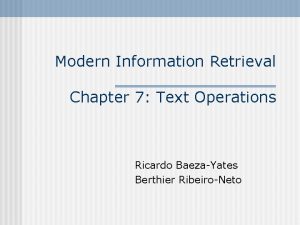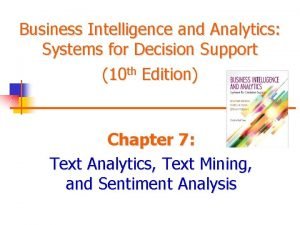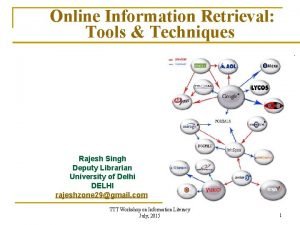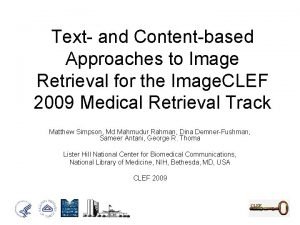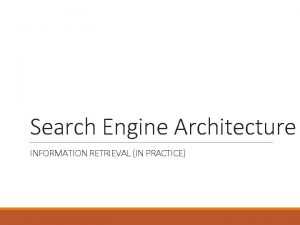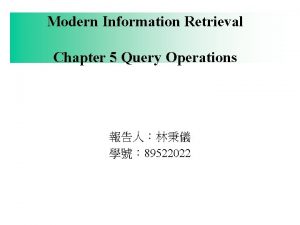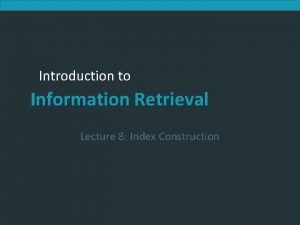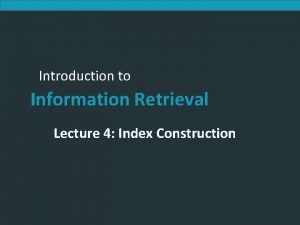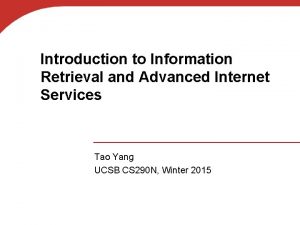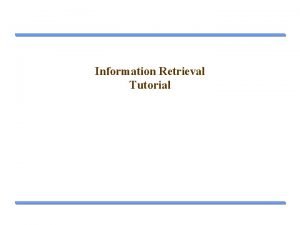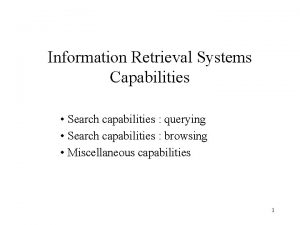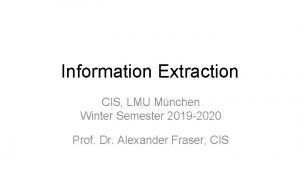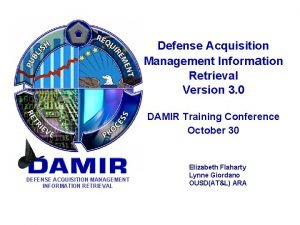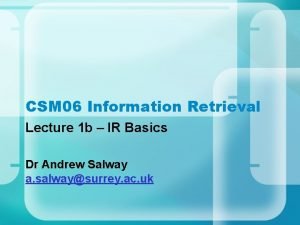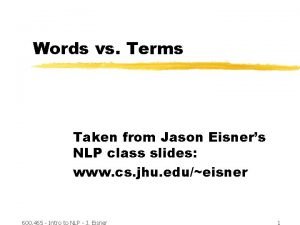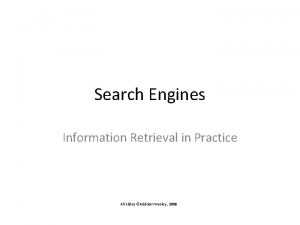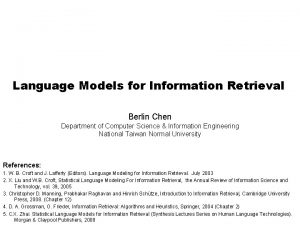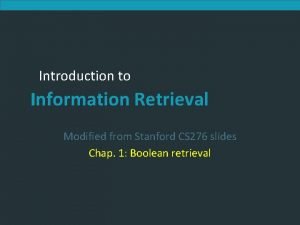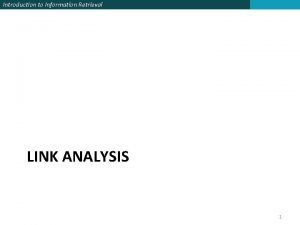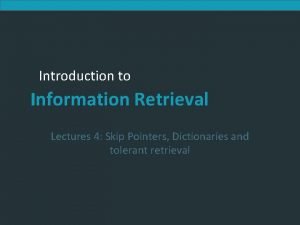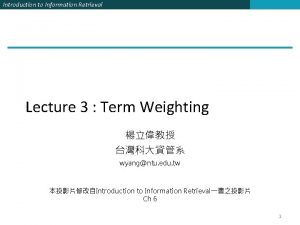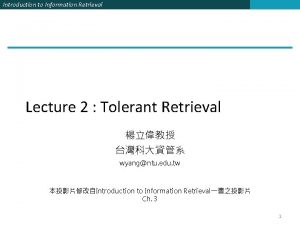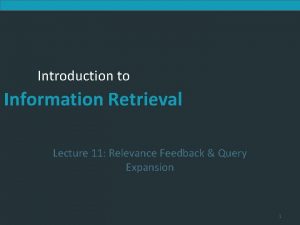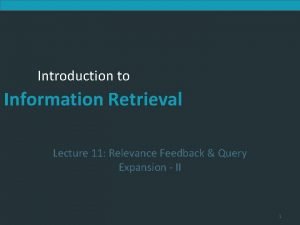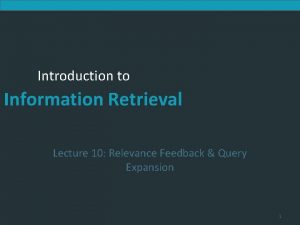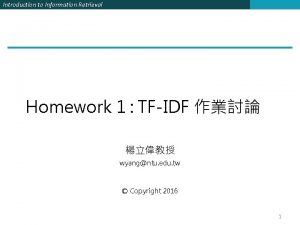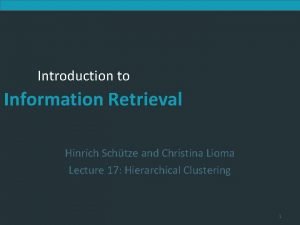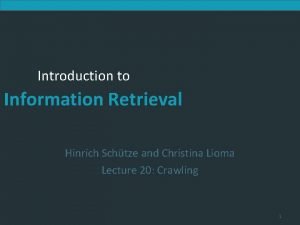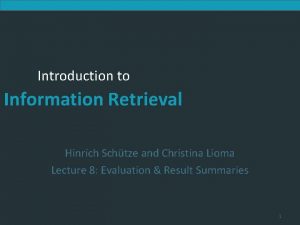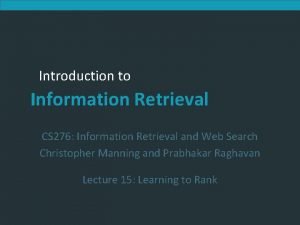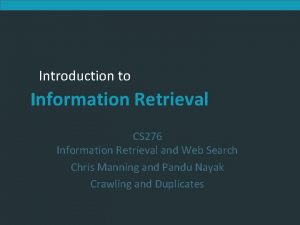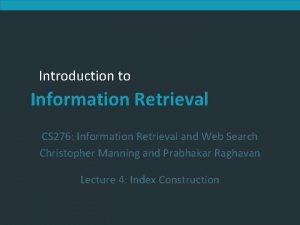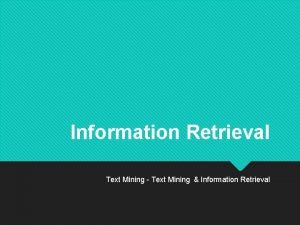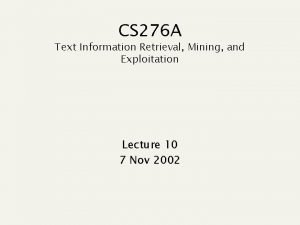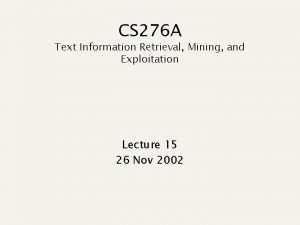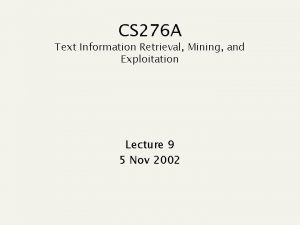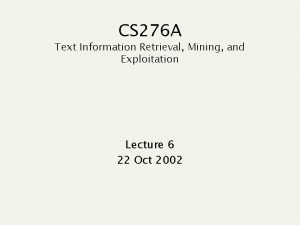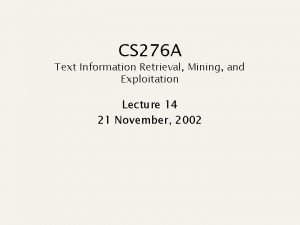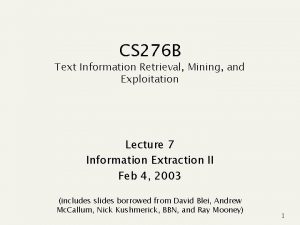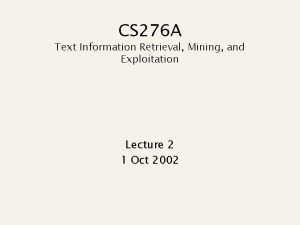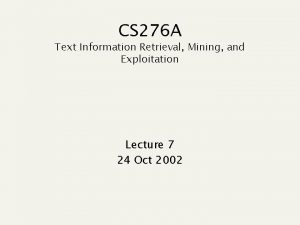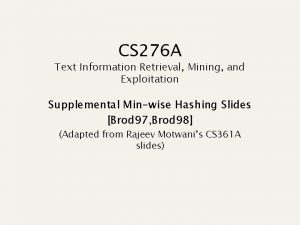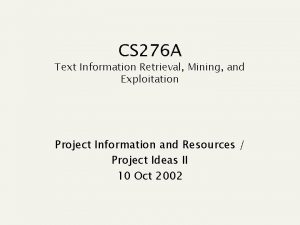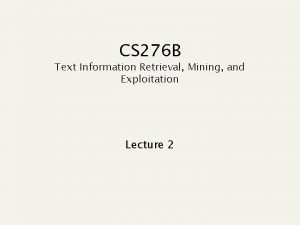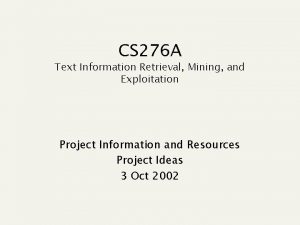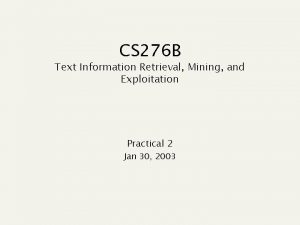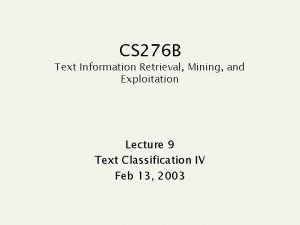CS 276 A Text Information Retrieval Mining and














![Stanford Web Base (179 K, 1998) [Cho 98] Perc. overlap with best x% by Stanford Web Base (179 K, 1998) [Cho 98] Perc. overlap with best x% by](https://slidetodoc.com/presentation_image/7f1458d85976d3c2540c2c506cdfc285/image-15.jpg)
![Web Wide Crawl (328 M pages, 2000) [Najo 01] BFS crawling brings in high Web Wide Crawl (328 M pages, 2000) [Najo 01] BFS crawling brings in high](https://slidetodoc.com/presentation_image/7f1458d85976d3c2540c2c506cdfc285/image-16.jpg)












![Computing Sketch[i] for Doc 1 Document 1 264 Start with 64 bit shingles Permute Computing Sketch[i] for Doc 1 Document 1 264 Start with 64 bit shingles Permute](https://slidetodoc.com/presentation_image/7f1458d85976d3c2540c2c506cdfc285/image-29.jpg)
![Test if Doc 1. Sketch[i] = Doc 2. Sketch[i] Document 2 Document 1 A Test if Doc 1. Sketch[i] = Doc 2. Sketch[i] Document 2 Document 1 A](https://slidetodoc.com/presentation_image/7f1458d85976d3c2540c2c506cdfc285/image-30.jpg)






![Bottom Up Mirror Detection [Cho 00] n n Maintain clusters of subgraphs Initialize clusters Bottom Up Mirror Detection [Cho 00] n n Maintain clusters of subgraphs Initialize clusters](https://slidetodoc.com/presentation_image/7f1458d85976d3c2540c2c506cdfc285/image-37.jpg)

![Top Down Mirror Detection [Bhar 99, Bhar 00 c] n E. g. , www. Top Down Mirror Detection [Bhar 99, Bhar 00 c] n E. g. , www.](https://slidetodoc.com/presentation_image/7f1458d85976d3c2540c2c506cdfc285/image-39.jpg)


![Connectivity Server [CS 1: Bhar 98 b, CS 2 & 3: Rand 01] n Connectivity Server [CS 1: Bhar 98 b, CS 2 & 3: Rand 01] n](https://slidetodoc.com/presentation_image/7f1458d85976d3c2540c2c506cdfc285/image-42.jpg)




![Term Vector Database [Stat 00] n Fast access to 50 word term vectors for Term Vector Database [Stat 00] n Fast access to 50 word term vectors for](https://slidetodoc.com/presentation_image/7f1458d85976d3c2540c2c506cdfc285/image-47.jpg)

- Slides: 48

CS 276 A Text Information Retrieval, Mining, and Exploitation Lecture 13 19 November, 2002

Recap n Last week n n web search overview pagerank HITS Last lecture n n n HITS algorithm using anchor text topic-specific pagerank

Today’s Topics n n Behavior-based ranking Crawling and corpus construction Algorithms for (near)duplicate detection Search engine / Web. IR infrastructure

Behavior-based ranking n n For each query Q, keep track of which docs in the results are clicked on On subsequent requests for Q, re-order docs in results based on click-throughs First due to Direct. Hit Ask. Jeeves Relevance assessment based on n n Behavior/usage vs. content

Query-doc popularity matrix B j Docs q Queries Bqj = number of times doc j clicked-through on query q When query q issued again, order docs by Bqj values.

Issues to consider n n Weighing/combining text- and click-based scores. What identifies a query? n n n Ferrari Mondial Ferrari mondial ferrari mondial “Ferrari Mondial” Can use heuristics, but search parsing slowed.

Vector space implementation n Maintain a term-doc popularity matrix C n n n as opposed to query-doc popularity initialized to all zeros Each column represents a doc j n If doc j clicked on for query q, update Cj Cj + q (here q is viewed as a vector). n n On a query q’, compute its cosine proximity to Cj for all j. Combine this with the regular text score.

Issues n n Normalization of Cj after updating Assumption of query compositionality n n “white house” document popularity derived from “white” and “house” Updating - live or batch?

Basic Assumption n n Relevance can be directly measured by number of click throughs Valid?

Validity of Basic Assumption n n Click through to docs that turn out to be non -relevant: what does a click mean? Self-perpetuating ranking Spam All votes count the same n More on this in recommendation systems

Variants n Time spent viewing page n n n Difficult session management Inconclusive modeling so far Does user back out of page? Does user stop searching? Does user transact?

Crawling and Corpus Construction n Crawl order Filtering duplicates Mirror detection

Crawling Issues n How to crawl? n n How much to crawl? How much to index? n n n Quality: “Best” pages first Efficiency: Avoid duplication (or near duplication) Etiquette: Robots. txt, Server load concerns Coverage: How big is the Web? How much do we cover? Relative Coverage: How much do competitors have? How often to crawl? n n Freshness: How much has changed? How much has really changed? (why is this a different question? )

Crawl Order n Best pages first n Potential quality measures: n n n Final Indegree Final Pagerank Crawl heuristic: n n BFS Partial Indegree Partial Pagerank Random walk
![Stanford Web Base 179 K 1998 Cho 98 Perc overlap with best x by Stanford Web Base (179 K, 1998) [Cho 98] Perc. overlap with best x% by](https://slidetodoc.com/presentation_image/7f1458d85976d3c2540c2c506cdfc285/image-15.jpg)
Stanford Web Base (179 K, 1998) [Cho 98] Perc. overlap with best x% by indegree x% crawled by O(u) Perc. overlap with best x% by pagerank x% crawled by O(u)
![Web Wide Crawl 328 M pages 2000 Najo 01 BFS crawling brings in high Web Wide Crawl (328 M pages, 2000) [Najo 01] BFS crawling brings in high](https://slidetodoc.com/presentation_image/7f1458d85976d3c2540c2c506cdfc285/image-16.jpg)
Web Wide Crawl (328 M pages, 2000) [Najo 01] BFS crawling brings in high quality pages early in the crawl

BFS & Spam (Worst case scenario) Start Page BFS depth = 2 Normal avg outdegree = 10 100 URLs on the queue including a spam page. Assume the spammer is able to generate dynamic pages with 1000 outlinks BFS depth = 3 2000 URLs on the queue 50% belong to the spammer BFS depth = 4 1. 01 million URLs on the queue 99% belong to the spammer

Adversarial IR (Spam) n Motives n n n Operators n n Commercial, political, religious, lobbies Promotion funded by advertising budget Contractors (Search Engine Optimizers) for lobbies, companies Web masters Hosting services Forum n Web master world ( www. webmasterworld. com ) n n Search engine specific tricks Discussions about academic papers

A few spam technologies n Cloaking n n n Doorway pages n n n Misleading meta-keywords, excessive repetition of a term, fake “anchor text” Hidden text with colors, CSS tricks, etc. Cloaking Y SPAM Is this a Search Engine spider? N Real Doc Link spamming n n n Pages optimized for a single keyword that redirect to the real target page Keyword Spam n n Serve fake content to search engine robot DNS cloaking: Switch IP address. Impersonate Mutual admiration societies, hidden links, awards Domain flooding: numerous domains that point or re-direct to a target page Robots n n n Fake click stream Fake query stream Millions of submissions via Add-Url Meta-Keywords = “… London hotels, hotel, holiday inn, hilton, discount, booking, reservation, sex, mp 3, britney spears, viagra, …”

Can you trust words on the page? auctions. hitsoffice. com/ Pornographic Content Examples from July 2002 www. ebay. com/

Search Engine Optimization I Adversarial IR (“search engine wars”)

Search Engine Optimization II Tutorial on Cloaking & Stealth Technology

The war against spam Quality signals - Prefer authoritative pages based on: n n n Votes from authors (linkage signals) Votes from users (usage signals) Policing of URL submissions Anti robot test Limits on meta-keywords n. Robust link analysis n n n Ignore statistically implausible linkage (or text) Use link analysis to detect spammers (guilt by association)

The war against spam n Spam recognition by machine learning n n Family friendly filters n n n Training set based on known spam Linguistic analysis, general classification techniques, etc. For images: flesh tone detectors, source text analysis, etc. Editorial intervention n Blacklists Top queries audited Complaints addressed

Duplicate/Near-Duplicate Detection n n Duplication: Exact match with fingerprints Near-Duplication: Approximate match n Overview n n Compute syntactic similarity with an editdistance measure Use similarity threshold to detect nearduplicates n n E. g. , Similarity > 80% => Documents are “near duplicates” Not transitive though sometimes used transitively

Computing Near Similarity n Features: Segments of a document (natural or artificial breakpoints) [Brin 95] n Shingles (Word N-Grams) [Brin 95, Brod 98] “a rose is a rose” => a_rose_is_a_rose is_a_rose_is n n Similarity Measure n n TFIDF [Shiv 95] Set intersection [Brod 98] (Specifically, Size_of_Intersection / Size_of_Union )

Shingles + Set Intersection Computing exact set intersection of shingles between all pairs of documents is expensive and infeasible n n Approximate using a cleverly chosen subset of shingles from each (a sketch)

Shingles + Set Intersection Estimate size_of_intersection / size_of_union based on a short sketch ( [Brod 97, Brod 98] ) n n Create a “sketch vector” (e. g. , of size 200) for each document Documents which share more than t (say 80%) corresponding vector elements are similar For doc D, sketch[ i ] is computed as follows: n n n Let f map all shingles in the universe to 0. . 2 m (e. g. , f = fingerprinting) Let pi be a specific random permutation on 0. . 2 m Pick sketch[i] : = MIN pi ( f(s) ) over all shingles s in D
![Computing Sketchi for Doc 1 Document 1 264 Start with 64 bit shingles Permute Computing Sketch[i] for Doc 1 Document 1 264 Start with 64 bit shingles Permute](https://slidetodoc.com/presentation_image/7f1458d85976d3c2540c2c506cdfc285/image-29.jpg)
Computing Sketch[i] for Doc 1 Document 1 264 Start with 64 bit shingles Permute on the number line pi 264 with 264 Pick the min value
![Test if Doc 1 Sketchi Doc 2 Sketchi Document 2 Document 1 A Test if Doc 1. Sketch[i] = Doc 2. Sketch[i] Document 2 Document 1 A](https://slidetodoc.com/presentation_image/7f1458d85976d3c2540c2c506cdfc285/image-30.jpg)
Test if Doc 1. Sketch[i] = Doc 2. Sketch[i] Document 2 Document 1 A 264 264 264 B 264 Are these equal? Test for 200 random permutations: p 1, p 2, … p 200 264

However… Document 2 Document 1 A 264 264 B 264 A = B iff the shingle with the MIN value in the union of Doc 1 and Doc 2 is common to both (I. e. , lies in the intersection) This happens with probability: Size_of_intersection / Size_of_union

Question n Document D 1=D 2 iff size_of_intersection=size_of_union ?

Mirror Detection n n Mirroring is systematic replication of web pages across hosts. n Single largest cause of duplication on the web Host 1/a and Host 2/b are mirrors iff For all (or most) paths p such that when http: //Host 1/ a / p exists http: //Host 2/ b / p exists as well with identical (or near identical) content, and vice versa.

Mirror Detection example n n http: //www. elsevier. com/ and http: //www. elsevier. nl/ Structural Classification of Proteins n n n http: //scop. mrc-lmb. cam. ac. uk/scop http: //scop. berkeley. edu/ http: //scop. wehi. edu. au/scop http: //pdb. weizmann. ac. il/scop http: //scop. protres. ru/

Repackaged Mirrors Auctions. msn. com Auctions. lycos. com Aug

Motivation n Why detect mirrors? n Smart crawling n n n Better connectivity analysis n n n Combine inlinks Avoid double counting outlinks Redundancy in result listings n n Fetch from the fastest or freshest server Avoid duplication “If that fails you can try: <mirror>/samepath” Proxy caching
![Bottom Up Mirror Detection Cho 00 n n Maintain clusters of subgraphs Initialize clusters Bottom Up Mirror Detection [Cho 00] n n Maintain clusters of subgraphs Initialize clusters](https://slidetodoc.com/presentation_image/7f1458d85976d3c2540c2c506cdfc285/image-37.jpg)
Bottom Up Mirror Detection [Cho 00] n n Maintain clusters of subgraphs Initialize clusters of trivial subgraphs n n n Group near-duplicate single documents into a cluster Subsequent passes n Merge clusters of the same cardinality and corresponding linkage n Avoid decreasing cluster cardinality To detect mirrors we need: n n Adequate path overlap Contents of corresponding pages within a small time range

Can we use URLs to find mirrors? www. synthesis. org c b a synthesis. stanford. edu d c d www. synthesis. org/Docs/Proj. Abs/synsys/synalysis. html synthesis. stanford. edu/Docs/Proj. Abs/deliv/high-tech-… www. synthesis. org/Docs/Proj. Abs/synsys/visual-semi-quant. html synthesis. stanford. edu/Docs/Proj. Abs/mech-enhanced… www. synthesis. org/Docs/annual. report 96. final. html synthesis. stanford. edu/Docs/Proj. Abs/mech-intro-… www. synthesis. org/Docs/cicee-berlin-paper. html synthesis. stanford. edu/Docs/Proj. Abs/mech-mm-case-… www. synthesis. org/Docs/myr 5 synthesis. stanford. edu/Docs/Proj. Abs/synsys/quant-dev-new-… www. synthesis. org/Docs/myr 5/cicee/bridge-gap. html synthesis. stanford. edu/Docs/annual. report 96. final. html www. synthesis. org/Docs/myr 5/cs/cs-meta. html synthesis. stanford. edu/Docs/annual. report 96. final_fn. html www. synthesis. org/Docs/myr 5/mech-intro-mechatron. html synthesis. stanford. edu/Docs/myr 5/assessment www. synthesis. org/Docs/myr 5/mech-take-home. html synthesis. stanford. edu/Docs/myr 5/assessment-… www. synthesis. org/Docs/myr 5/synsys/experiential-learning. html synthesis. stanford. edu/Docs/myr 5/assessment/mm-forum-kiosk-… www. synthesis. org/Docs/myr 5/synsys/mm-mech-dissec. html synthesis. stanford. edu/Docs/myr 5/assessment/neato-ucb. html www. synthesis. org/Docs/yr 5 ar synthesis. stanford. edu/Docs/myr 5/assessment/not-available. html www. synthesis. org/Docs/yr 5 ar/assess synthesis. stanford. edu/Docs/myr 5/cicee www. synthesis. org/Docs/yr 5 ar/cicee synthesis. stanford. edu/Docs/myr 5/cicee/bridge-gap. html www. synthesis. org/Docs/yr 5 ar/cicee/bridge-gap. html synthesis. stanford. edu/Docs/myr 5/cicee-main. html www. synthesis. org/Docs/yr 5 ar/cicee/comp-integ-analysis. html synthesis. stanford. edu/Docs/myr 5/cicee/comp-integ-analysis. html
![Top Down Mirror Detection Bhar 99 Bhar 00 c n E g www Top Down Mirror Detection [Bhar 99, Bhar 00 c] n E. g. , www.](https://slidetodoc.com/presentation_image/7f1458d85976d3c2540c2c506cdfc285/image-39.jpg)
Top Down Mirror Detection [Bhar 99, Bhar 00 c] n E. g. , www. synthesis. org/Docs/Proj. Abs/synsys/synalysis. html synthesis. stanford. edu/Docs/Proj. Abs/synsys/quant-dev-new-teach. html n What features could indicate mirroring? n Hostname similarity: n n Directory similarity: n n Positional path bigrams { 0: Docs/Proj. Abs, 1: Proj. Abs/synsys, … } IP address similarity: n n word unigrams and bigrams: { www, www. synthesis, …} 3 or 4 octet overlap Many hosts sharing an IP address => virtual hosting by an ISP Host outlink overlap Path overlap n Potentially, path + sketch overlap

Implementation n Phase I - Candidate Pair Detection n Find features that pairs of hosts have in common Compute a list of host pairs which might be mirrors Phase II - Host Pair Validation n Test each host pair and determine extent of mirroring n Check if 20 paths sampled from Host 1 have nearduplicates on Host 2 and vice versa n Use transitive inferences: IF Mirror(A, x) AND Mirror(x, B) THEN Mirror(A, B) IF Mirror(A, x) AND !Mirror(x, B) THEN !Mirror(A, B) n Evaluation n n 140 million URLs on 230, 000 hosts (1999) Best approach combined 5 sets of features n Top 100, 000 host pairs had precision = 0. 57 and recall = 0. 86

Web. IR Infrastructure n Connectivity Server n n Fast access to links to support for link analysis Term Vector Database n Fast access to document vectors to augment link analysis
![Connectivity Server CS 1 Bhar 98 b CS 2 3 Rand 01 n Connectivity Server [CS 1: Bhar 98 b, CS 2 & 3: Rand 01] n](https://slidetodoc.com/presentation_image/7f1458d85976d3c2540c2c506cdfc285/image-42.jpg)
Connectivity Server [CS 1: Bhar 98 b, CS 2 & 3: Rand 01] n n Fast web graph access to support connectivity analysis Stores mappings in memory from n n URL to outlinks, URL to inlinks Applications n n n HITS, Pagerank computations Crawl simulation Graph algorithms: web connectivity, diameter etc. n n more on this later Visualizations

Usage Input Graph algorithm + URLs + Values URLs to FPs to IDs Execution Output Graph algorithm runs in memory URLs + Values IDs to URLs Translation Tables on Disk URL text: 9 bytes/URL (compressed from ~80 bytes ) FP(64 b) -> ID(32 b): 5 bytes ID(32 b) -> FP(64 b): 8 bytes ID(32 b) -> URLs: 0. 5 bytes

ID assignment n Partition URLs into 3 sets, sorted lexicographically n n High: Max degree > 254 Medium: 254 > Max degree > 24 Low: remaining (75%) IDs assigned in sequence (densely) E. g. , HIGH IDs: Max(indegree , outdegree) > 254 ID URL … 9891 www. amazon. com/ 9912 www. amazon. com/jobs/ … 9821878 www. geocities. com/ … Adjacency lists § In memory tables for Outlinks, Inlinks § List index maps from a Source ID to start of adjacency list 40930030 www. google. com/ … 85903590 www. yahoo. com/

Adjacency List Compression - I … 104 105 106 … List Index … 98 132 153 98 147 153 … Sequence of Adjacency Lists … 104 105 106 … List Index … -6 34 21 -8 49 6 … Delta Encoded Adjacency Lists • Adjacency List: - Smaller delta values are exponentially more frequent (80% to same host) - Compress deltas with variable length encoding (e. g. , Huffman) • List Index pointers: 32 b for high, Base+16 b for med, Base+8 b for low - Avg = 12 b per pointer

Adjacency List Compression - II n Inter List Compression n Basis: Similar URLs may share links n n Close in ID space => adjacency lists may overlap Approach n Define a representative adjacency list for a block of IDs n n Adjacency list of a reference ID Union of adjacency lists in the block Represent adjacency list in terms of deletions and additions when it is cheaper to do so Measurements n n Intra List + Starts: 8 -11 bits per link (580 M pages/16 GB RAM) Inter List: 5. 4 -5. 7 bits per link (870 M pages/16 GB RAM. )
![Term Vector Database Stat 00 n Fast access to 50 word term vectors for Term Vector Database [Stat 00] n Fast access to 50 word term vectors for](https://slidetodoc.com/presentation_image/7f1458d85976d3c2540c2c506cdfc285/image-47.jpg)
Term Vector Database [Stat 00] n Fast access to 50 word term vectors for web pages n Term Selection: n n n Term Weighting: n n Deferred till run-time (can be based on term freq, doc length) Applications n n Restricted to middle 1/3 rd of lexicon by document frequency Top 50 words in document by TF. IDF. Content + Connectivity analysis (e. g. , Topic Distillation) Topic specific crawls Document classification Performance n n Storage: 33 GB for 272 M term vectors Speed: 17 ms/vector on Alpha. Server 4100 (latency to read a disk block)

Architecture URLid * 64 /480 offset URL Info Base (4 bytes) LC: TID Terms LC: TID … Bit vector For 480 URLids LC: TID FRQ: RL Freq FRQ: RL … FRQ: RL URLid to Term Vector Lookup 128 Byte TV Record
 Text and web mining
Text and web mining Text operations in information retrieval
Text operations in information retrieval What is an example of a text-to-media connection?
What is an example of a text-to-media connection? Text analytics and text mining
Text analytics and text mining Text analytics and text mining
Text analytics and text mining Difference between strip mining and open pit mining
Difference between strip mining and open pit mining Precision and recall in information retrieval
Precision and recall in information retrieval Information retrieval and web search
Information retrieval and web search Information retrieval data structures and algorithms
Information retrieval data structures and algorithms Examples of information retrieval tools
Examples of information retrieval tools Signature file structure in information retrieval system
Signature file structure in information retrieval system Strip mining vs open pit mining
Strip mining vs open pit mining Chapter 13 mineral resources and mining
Chapter 13 mineral resources and mining Mining multimedia databases
Mining multimedia databases Mining complex types of data in data mining
Mining complex types of data in data mining Text based image retrieval
Text based image retrieval Text retrieval software
Text retrieval software What is sequential search
What is sequential search Search engine architecture
Search engine architecture Query operations in information retrieval
Query operations in information retrieval For skip pointer, more skip leads to
For skip pointer, more skip leads to Index construction in information retrieval
Index construction in information retrieval Spimi
Spimi Which internet service is used for information retrieval
Which internet service is used for information retrieval Information retrieval tutorial
Information retrieval tutorial Wildcard query in information retrieval
Wildcard query in information retrieval Information retrieval system capabilities
Information retrieval system capabilities Link analysis in information retrieval
Link analysis in information retrieval Information retrieval lmu
Information retrieval lmu Defense acquisition management information retrieval
Defense acquisition management information retrieval Advantages of information retrieval system
Advantages of information retrieval system Information retrieval nlp
Information retrieval nlp Information retrieval slides
Information retrieval slides Relevance information retrieval
Relevance information retrieval Information retrieval stanford
Information retrieval stanford Link analysis in information retrieval
Link analysis in information retrieval Which is a good idea for using skip pointers?
Which is a good idea for using skip pointers? Anthony julius
Anthony julius Levenshtein distance for oslo-snow
Levenshtein distance for oslo-snow Information retrieval
Information retrieval Information retrieval
Information retrieval Relevance information retrieval
Relevance information retrieval Information retrieval
Information retrieval Information retrieval
Information retrieval Url image
Url image Information retrieval
Information retrieval Information retrieval
Information retrieval Information retrieval
Information retrieval Cs 276
Cs 276

